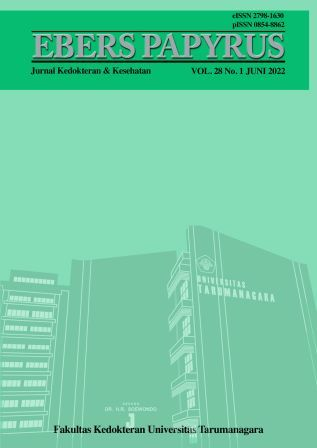HUBUNGAN TINGKAT DEPRESI DENGAN KEKUATAN GENGGAMAN TANGAN PADA MAHASISWA FAKULTAS KEDOKTERAN UNIVERSITAS TARUMANAGARA
Main Article Content
Abstract
Depresi merupakan gangguan mental yang ditandai dengan perubahan suasana hati, kesedihan terus menerus, kehilangan motivasi dan semangat serta ketidakmampuan untuk melakukan aktivitas sehari-hari selama 2 minggu. Depresi dapat menyebabkan penurunan fungsi fisik yang berpotensi mengubah komposisi tubuh dan metabolisme. Penelitian ini bertujuan untuk mengetahui hubungan tingkat depresi dengan kekuatan genggaman tangan pada mahasiswa Fakultas Kedokteran Universitas Tarumanagara. Penelitian ini menggunakan metode cross sectional dengan 176 responden. Data tingkat depresi didapatkan dengan cara responden mengisi kuesioner Hamilton Rating Scale for Depression (HRSD) dan kekuatan genggaman tangan diukur menggunakan alat Camry Electronic Hand Dynamometer model EH101. Data yang diperoleh akan diuji analisis menggunakan uji chi-square. Hasil dari uji analisis didapatkan p value = 0,003 dan prevalence ratio sebesar 1,4. Dari hasil tersebut menunjukkan adanya hubungan yang bermakna antara tingkat depresi dengan kekuatan genggaman tangan dan variabel tersebut merupakan faktor resiko.
Article Details

This work is licensed under a Creative Commons Attribution-NonCommercial-ShareAlike 4.0 International License.
Naskah yang diterima adalah naskah asli yang belum pernah dimuat dalam jurnal lain dan tidak sedang dalam proses untuk dimuat dalam majalah lain dalam waktu yang bersamaan. Naskah yang diterbitkan merupakan hak milik penerbit dan tidak akan dikembalikan, sedangkan naskah yang dinilai tidak layak diterbitkan akan dikembalikan. Naskah yang masuk akan dinilai oleh mitra bestari. Tim editor mempunyai hak melakukan pengeditan sesuai gaya selingkung untuk naskah yang akan diterbitkan.
References
World Health Organization. Depression: mental health. 2017 (cited 2017 April 7). Available from:https://www.who.int/mental_health/management/depression/en/
Thapar A, Collishaw S, Pine DS, Thapar AK. Depression in adolescence. The Lancet. 2012;379:1056-67.
National Institute of Mental Health. Depression. 2018 (cited 2018 February). Available from:https://www.nimh.nih.gov/health/topics/depression/index.shtml
Alvi T, Assad F, Ramzan M, Khan FA. Depression, anxiety and their associated factors among medical students. Journal of the College of Physicians and Surgeons Pakistan. 2010;20(2):122-26.
Robert HC, Denison HJ, Martin HJ, Patel HP, Syddall H, Cooper C, et al. A review of the measurement of grip strength in clinical and epidemiological studies: towards a standardised approach. Oxford University Press on behalf of the British Geriatrics Society. 2011;423-29.
Smith L, White S, Stubbs B, Hu L, Veronese N, Vancampfort D, et al. Depressive symptoms, handgrip strength, and weight status in US older adults. Journal of Affective Disorders. 2018;305-10.
Lee MR, Jung SM, Bang H, Kim HS, Kim YB. The association between muscular strength and depression in Korean adults: A cross-sectional analysis of the sixth Korea National Health and Nutrition Examination Survey (KNHANES VI) 2014 11 medical and health sciences 1117 public health and health servic. BMC Public Health. 2018;18:1123.
Al-Asadi JN. Handgrip strength in medical students: Correlation with body mass index and hand dimensions. Asian Journal of Medical Sciences. 2018;9(1).
Manoharan VS, Sundaram SG, Jason JI. Factors affecting hand grip strength and its evaluation: A systemic review. International Journal of Physiotherapy and Research. 2015;3(6):1288-93.
Rahmawati AT. Perbedaan derajat depresi antara mahasiswa kedokteran preklinik dengan klinik di Universitas Islam Negeri Syarif Hidayatullah Jakarta tahun 2012. Jakarta; 2012.
Lee K. Relative handgrip strength in relation to depressive mood and suicidal ideation in koreans using the 2015 KNHANES data. Journal of Musculoskeletal Neuronal Interactions. 2018;18(3):333-38.
Smith L, Firth J, Grabovac I, Koyanagi Ai, Veronese N, Stubbs B, et al. The association of grip strength with depressive symptoms and cortisol in hair: A cross?sectional study of older adults. Scand J Med Sci Sports. 2019;1-6.



